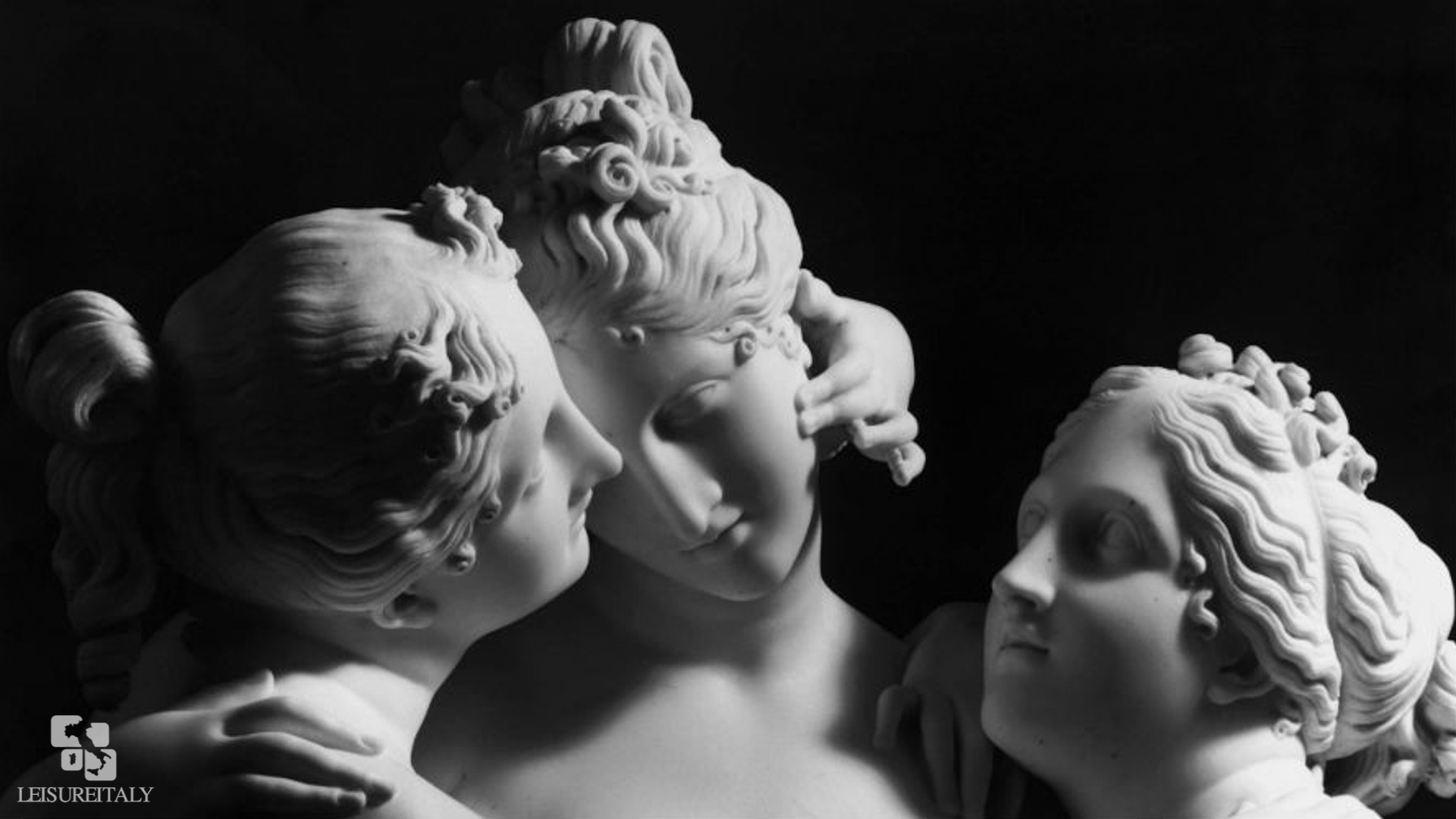
La mia arte Canova e Thorvaldsen Le tre Grazie
The Three Graces is a marble statue sculpted in Rome by Antonio Canova between 1813 and 1816. The work exemplifies the aesthetics of neoclassicism, a cultura.

Le Tre Grazie Mostra “Canova Thorvaldsen” Gallerie d'Italia di
Antonio Canova was born in 1757 in Possagno, a small town in northern Italy, to a family of stonecutters and sculptors. From his early teens he trained with several local sculptors, before moving to Venice where he was able to start an independent career. At around the age of 20 he carved his first marbles, Eurydice and Orpheus and Daedalus and.

Antonio Canova. Le tre Grazie 1798 Three graces, Italian artist
Canova mentioned "various ideas on dances, the play between nymphs and cupids, muses, philosophers, etc., sketched exclusively for the artist's own study and enjoyment." There is little doubt he was referring to the tempera cycle at Possagno and similar sketches now in Bassano. Picking up the themes and techniques discovered in Herculaneum.

Unfolding of Antonio Canova's Three Graces Statue Getty Images
The Three Graces were the daughters of Zeus and companions to the Muses in bestowing their gifts upon humanity. Canova depicts them from left to right as Euphrosyne (mirth), Aglaio (elegance) and Thalia (youth and beauty and has sculpted the three as exquisitely articulated young women in a touching and intricate embrace. Provenance

V&A · The Three Graces By Antonio Canova
Taking its motif from ancient Greek literature, The Three Graces depicts the three daughters of Zeus, each of whom is described as being able to bestow a particular gift on humanity: (from left to right) Euphrosyne (mirth), Aglaia (elegance) and Thalia (youth and beauty).

Canova comes to the MANN of Naples Leisure Italy
Antonio Canova's statue The Three Graces is a Neoclassical sculpture, in marble, of the mythological three Charites, daughters of Zeus - identified on some engravings of the statue as, from left to right, Euphrosyne, Aglaea and Thalia - who were said to represent youth/beauty , mirth , and elegance . The Graces presided over banquets and gatherings, to delight the guests of the gods.

Study for 'The Three Graces' by Antonio Canova, . Canova was an... News
A very popular theme among historical artists is a collection of 3 female figures from Greek Mythology. These are referred to as the "Charites" or "Graces" and have been both painted and sculpted numerous times. Let's take a closer look at "The Three Graces" by Antonio Canova (1757-1822), some of the most impressive works in the oeuvre of this renowned Neoclassical sculptor.

L'angelo senza ali di Canova vola a New York era stato ritrovato in
The Graces are the three daughters of Zeus and Oceanid Eurynome: Aglaea, goddess of splendor, Euphrosyne, representing joy and delight, and Thalia,embodying prosperity. The Graces (1813) by Antonio.

Pin su Canova. Il segno della gloria
The Three Graces, 1813-16 Antonio Canova. The State Hermitage Museum, St. Petersburg, Russia. © Ghigo G. Roli / Art Resource, NY Works like The Three Graces began as small and loosely modeled sketches— bozzetti in Italian— where the artist raced to materialize his ideas in clay.

Recordbreaking Canova sold for £5.3 million All About Italy
[1] Canova was universally acknowledged to be the preeminent sculptor — for many, the dominant artist — of his era. Determined to have a work from his hand, the countess negotiated a contract, signed by Canova on April 14, 1804, for a version of the artist's marble Perseus with the Head of Medusa (1797-1801).[2]

Classical Statue Of Pauline Bonaparte, Made By Antonio Canova Editorial
The Three Graces by Antonio Canova, Victoria and Albert Museum (43 F) Media in category "The Three Graces by Antonio Canova" The following 15 files are in this category, out of 15 total. De drie gratiën Sculpturen van Antonio Canova (serietitel), RP-P-OB-36.456.jpg 1,958 × 2,500; 1.12 MB
.jpg)
48 best ideas for coloring The Three Graces
Opera The Three Graces, a 1908 opera that opened at the Chicago Opera House and starred such performers as Trixie Friganza The Three Graces ( Три грации ), a 1988 Russian opera parody composed by Vladimir Tarnopolski Other uses Theological virtues, specifically faith, hope and charity

Napoli, "Canova e l'antico" le Tre Grazie e 110 opere al Mann L'arte
Illustration. by Antonio Canova. published on 05 October 2023. Download Full Size Image. The Three Graces, statue by Italian sculptor Antonio Canova, commissioned at the behest of Empress Joséphine de Beauharnais, c. 1813-1816. Hermitage Museum, St. Petersburg. Remove Ads.

Pin on музеи мира
Antonio Canova's statue The Three Graces is a Neoclassical sculpture, in marble, of the mythological three Charites, daughters of Zeus - identified on some engravings of the statue as, from left to right, Euphrosyne, Aglaea and Thalia - who were said to represent youth/beauty (Thalia), mirth (Euphrosyne), and elegance (Aglaea). The Graces presided over banquets and gatherings, to delight.

A copy of a statue known as the Three Graces by Antonio Canova... News
The State Hermitage MuseumSt. Petersburg, Russia. A late work by Canova, The Three Graces was produced at a time when the artist was so famous that the public eagerly awaited each new work. Faithful to the Neoclassical ideal, Canova embodied his perceptions of beauty in the form of the ancient goddesses who were said to personify feminine charm.

Antonio Canova, Tre Grazie YouTube
Le Tre Grazie è il nome assegnato a due sculture di Antonio Canova ritraenti le tre famose dee della mitologia greca: Grazieus, Graziellis e Grazialcazzo; realizzate tra il 1812 e il 1817.